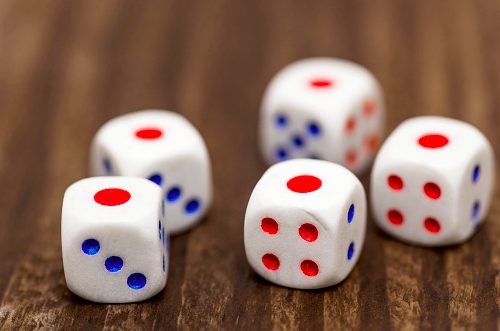
Have you ever wondered about the chances of getting your desired outcomes in board games or the number of dice games?
The occurrence of specific results in the stream of events is called probability. Probability gives the numerical description of the desired outcome. For example, while tossing a coin, we have two outcomes, i.e., head or tail. Probability gives an estimate of the chances of getting your required outcome based on the number of trials conducted or the theoretical probability method.
An event in the dice game is referred to as chances of getting the desired number in the 6 possible outcomes: 1,2,3,4,5 and 6. While rolling two dice simultaneously increases the scope of the sample size; accordingly, you can form various questions.
In this article, we have explained the probabilities of rolling doubles.
But first, let’s learn the:
Definition of Probability
P(E) = Number of ways in which an event can occur/Total number of possible outcomes
Where P(E) is the probability of an event to occur
Terms Related to Probability
- Trial – Series of random action of any event
Example: Rolling the dice, tossing the coin, etc.
- Event – individual output of a trial
Example: Getting the output of numbers in the dice rolling, heads in tossing coins, etc.
- Sample Space – Total number of possibilities in which the event can occur.
Example: For tossing a coin sample space is {H,T}, rolling a dice, sample space becomes {1,2,3,4,5,6}.
- Outcome – The result of any trial conducted
Example: We get a number between 1 to 6 when rolling a dice, which is a possible outcome.
- Equally Likely event –
When events have the same probability of every outcome, we call that an Equally Likely Event.
For example – Rolling the dice as getting 2 or 6 has an equal probability, tossing the coin, which has the possibility of heads and tails.
It starts with understanding the basic maths behind the rolling of single dice and then explaining the two dice rolling concepts.
Rolling of Single dice
The most specific event having the sample space larger than tossing the coin is rolling the dice. Guessing the probability of the desired event’s occurrence is explained, and the concepts are further developed in the event where multiple dice are rolled. In single dice, the sample space contains 6 possible outcomes. On rolling dice, one out of these 6 numbers will occur. So, calculating the probability of that event is given as:
For example, if we get 3 as an outcome of the trial, how 3 can occur is one, and the total number of possible outcomes, i.e., events in sample space, is 6. Hence, the probability of occurrence of 3 is 1/6 or 0.167.
So, the calculation of probability for single dice gives a basic understanding of the further types of conditions attached with the dice rolling.
Single dice rolling problems come under the theoretical probability, which deals with a reasonable probability as dice rolling outputs have the same probability of 16. Similarly, for tossing a coin, the probability of head comes up to 12. Two other types of probability are Experimental probability and Axiomatic probability. The experimental probability deals with probability, which is calculated based on the total possible outcomes to the total number of trials. The Axiomatic Probability decides on the set of rules set up under Kolmogorov’s three axioms where the success and failure can be quantified.
Note: For such an event which is not part of sample space, the probability is 0 as it has no chance to occur. Whereas events, where the output is equal to the number of outcomes in sample space, is called certainty, and the probability is 1.
Rolling of Double dice
The problem grows as we move on to calculate the probability of rolling two dices separately. The sample space increases accordingly. While rolling two dice at a time, we need to specify the x as the first dice and y as the second dice to form the sample space (x, y). As each dice output will be from 1 to 6; hence, x or y would vary between specified ranges, i.e., 1 to 6.
Sample space of the two dice rolling is given as :
E={(1,1), (1,2), (1,3), (1,4), (1,5), (1,6), (2,1), (2,2), (2,3), (2,4), (2,5), (2,6), (3,1), (3,2), (3,3), (3,4), (3,5), (3,6), (4,1), (4,2), (4,3), (4,4), (4,5), (4,6), (5,1), (5,2), (5,3), (5,4), (5,5), (5,6), (6,1), (6,2), (6,3), (6,4), (6,5), (6,6),}
The sample space’s total size grows to 36 as x has 6 possible outcomes, and y also has 6 possible outcomes. Hence, for (x, y) it becomes 66 = 36. These 36 individual cases are the sample space of the probability trials. After forming the sample space, we need to identify the possible events, which are subsets of the sample space.
For example, to get the events in which the sum of two dice comes up 4, we look for the possible cases, and the events which have such possibility is given by E, which is
E = {(1, 3), (2, 2), (3, 1)}
Possible events having the outcome of first and second dice sums up to 4 are listed.
Considering the next step, each event in the dice is fair and independent, so each event possibility (x, y) is equally likely to occur. So, all 36 possibilities represent a singleton event, and also the probabilities of every occurrence must sum up to 1, so each singleton event (x, y) is assigned 1/36.
E is composed of 3 single events, the probability of sum to appear 4 in rolling two dice, P(E) becomes 3/36 = 1/12 = 0.0833 or 8.33 %.
Generalizing the concept, when two dice are fair and independent, we need to divide the number of items in the outcome set with total events, which are 36.
Probability of two independent events
The formula gives the probability of an event to occur where the outcome depends on two individual cases.
Probability of two different cases = Probability of the first outcome * probability of the second outcome.
In two dice rolling cases, the outcome of both dice is independent or mutually exclusive. Therefore, to calculate the probability in the cases where specific outcome probability is asked, we use this method.
For example,
If you need to calculate the probability of getting 2 on the first dice and 4 on the other, both individual dice need to have P(E) = 1/6. Hence, the probability becomes 1/6*1/6 = 1/36 = 0.0278 or 2.78 % as per the explained concept.
Failure of an event
To calculate the failure of any event, as per the probability theory, the sum of all the events equals 1. So, in case of calculating the failure probability, we require to subtract the chance of success from 1.
P(Failure of any event) = 1 – P(Success of an event)
Probability of Rolling Doubles
Taking the case where the same number occurs while rolling the dice, this selection explains the concept of the rolling doubles in different ways :
Question – In rolling the dice and the probability of getting the same number in both the dice is given by:-
Solution-
Probability of getting the same number in both dice roll :
Required outcome – {(1,1), (2,2), (3,3), (4,4), (5,5), (6,6)}
P(Same number in both dice roll) = 6 ( Total number of the desired outcome )/36 (Total number of the possible outcome in the trial )= 1/6 = 0.167
The probability of rolling doubles is 0.167 or 16.7%.
Question – What is the probability of not getting rolling doubles?
Solution –
To calculate the probability of the event of two numbers not coming consecutively in dice rolling is given by subtracting the success of both numbers co-occurring from 1.
P(Two number not coming simultaneously) = 1 – P(Same number in the both dice roll)
= 1 – 0.167
= 0.833
Hence, the result is 0.833, or 83.3 %.
6-sided dice problems are very commonly asked questions in statistics and probability. The questions are framed based on the rolling of multiple dice, where we need to follow steps to create the sample size and then calculate the probability of the desired outcome. Questions related to rolling the next dice based on the outcome of the first dice output (inclusive event) are also asked, forming a higher-level question.
Further concepts that “Probability” deals with cases like mutually exclusive events, inclusive events, and other interesting domains like the ball’s color in bags, tossing a coin, etc. are the best examples to explore for the students to understand the probability at a basic level.
Having an idea about calculating the probability and solving dice problems would motivate you to explore more about topics dealing with probability and data. Higher concepts like Machine Learning are based on Data and probability. A good understanding of probability and its basic knowledge would give you an edge in these concepts. Data provides an estimate to calculate the probability for any event to consider it as success or failure or predict the specific event’s occurrence. It is based on which algorithms are created with expert teachers at Cuemath to learn more about what is data and probability. Start with understanding the application of data and calculate the probability, which is the bedrock on which Machine Learning concepts are built up !!






